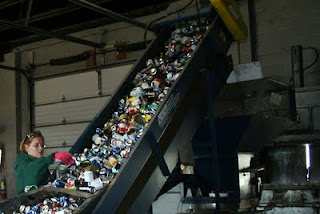The Chesapeake Bay Roasting Company (CBRC) has always maintained “sustainability and community outreach” as a company wide mantra. Their business decisions have reflected such since the company’s inception ten years ago and their decision of using steel packaging for their product embraces that trend.
“Back in the day, most every coffee product was in steel [containers],” says Neil Cooper, SVP of marketing and sales at CBRC. “Premium products started to use bags in place of steel cans, so the products using steel cans were the mid or lower priced coffee products. We decided to enter the premium priced segment and to celebrate the unique qualities of steel while using contemporary graphics and design characteristics as a point of difference versus our competitors.”
CBRC is not alone in their choice to use more sustainable packaging. With over 1.5 million net tons of steel packaging recycled last year, and a recycling rate of 67%, the public is showing that a sustainable and recyclable packaging material is a factor in their home purchasing needs.
“It is important to most people when they see us at an event, a customer coffee tasting, or at a water clean-up effort, they take notice,” according to Chris Paladino, CEO of CBRC. “They also tell their friends and business associates about a local company that is making an effort!”
In addition to their packaging, CBRC has and continues to differentiate itself from competitors by being involved in local events or causes. They purchase wind power, utilize distribution partners to collect used coffee grounds for farming compost and sponsor river clean-ups. Most employees are also involved in environmental organizations such as Trout Unlimited, the Severn River Partnership, and Silver Spring Green, among others.
The commitment to the environment is no better reflected than in CBRC’s established community outreach program called the ‘H2O Initiative.’ Its primary goal is to preserve and protect the Chesapeake Bay watershed, which extends across six states and almost 17 million Americans. CBRC pledges 2% of all coffee sales annually to go back in support of organizations that help to improve the health of the Chesapeake Bay watershed. By including the H2O Initiative symbol on products, the hope is to encourage other companies and organizations to join CBRC’s program and find ways to make a difference.
Part of that difference includes reassessing packaging for environmental impact and its overall life cycle assessment in terms of sustainability without sacrificing a quality product.
“Steel is the perfect material to protect coffee beans from ‘the enemy’ [light, air and moisture],” says Paladino. “Recycle, Re-use, Repurpose is possible by using steel versus the non-recyclable materials used by most of our competitors. Our decision to use steel as our packaging choice came down to a commitment to the environment versus ‘low cost’ packaging alternatives.”
CBRC’s decision has thus far been a success, recently entering partnerships to be distributed in the Fair Trade Organic sections of regional Giant Food stores and Whole Foods’entire Mid-Atlantic region.
Much like the life cycle of their steel cans, CBRC’s efforts at making a difference are continuous and consumers are definitely taking notice.
For more information on CBRC and their programs, visit their website. To learn more about the benefits of packaging with steel, as well as a locator to find recycling locations for CBRC’s steel packages and other steel products, visit SRI’s website.


 That statement begins the description of the American Institute of Steel Reclamation (AISR). Designed by Jeff Dahl and Jan Lim, AISR is an educational institute concept that is designed to be incorporated around a functioning scrap yard. Their unique design and idea was strong enough to win 1st place in the 2008-2009 Association of Collegiate Schools of Architecture (ACSA)/American Institute of Steel Construction (AISC) Steel Design Student Competition.
That statement begins the description of the American Institute of Steel Reclamation (AISR). Designed by Jeff Dahl and Jan Lim, AISR is an educational institute concept that is designed to be incorporated around a functioning scrap yard. Their unique design and idea was strong enough to win 1st place in the 2008-2009 Association of Collegiate Schools of Architecture (ACSA)/American Institute of Steel Construction (AISC) Steel Design Student Competition.



